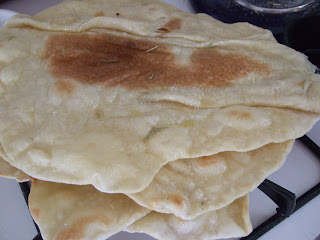I'd like to focus on ciabatta for a while. I have yet to achieve the "airy" quality deriving from big interior holes in this bread, and no doubt my handling of the dough is partly responsible. Luckily it's tasty even if not correct.
This bread was an adaptation of Peter Reinhart's poolish-method ciabatta, using my sourdough starter. I fed the starter and increased the hydration to something like a poolish consistency, and then I simply replaced the poolish quantity with the starter and omitted the commercial yeast. My starter had been fed with both a rye blend and bread flours from King Arthur.
All of the commentators on ciabatta agree: this dough has to be wet, as wet as you can make it. I used milk and water and gave it a go in the stand mixer, then took it through several stretch-and-folds on a bed of flour. I picked up the trick from another cookbook of doing this stage in a casserole dish (it holds the wet dough and the bed of flour pretty well). I gather from some breadmaking sources that you actually want to use a softer flour for ciabatta, but I have yet to test this out.
I also used the option in The Bread Maker's Apprentice of caramelizing some onions and adding some herbs (tarragon), which are all added to the dough during stretch-and-fold operations. The final rise is on floured cloth. The bread (which was definitely puffy -- perhaps it deflated in the transfer to the oven?) is baked on parchment, on a hot stone.









